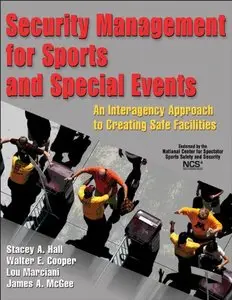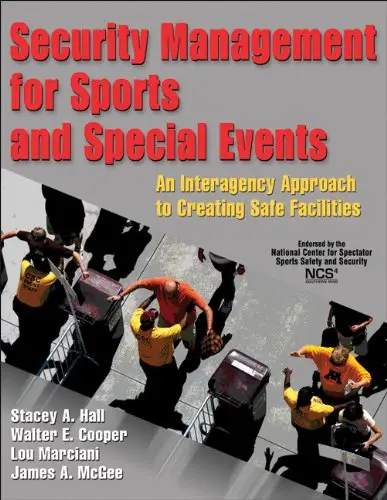Security Management for Sports and Special Events: An Interagency Approach to Creating Safe Facilities by Stacey Hall, Walter Cooper, Lou Marciani and Jim McGee
English | 2011 | ISBN: 0736071326 | 280 pages | PDF | 4 MB
English | 2011 | ISBN: 0736071326 | 280 pages | PDF | 4 MB
Though spectator and player security has always been a priority for sport and facility managers at all levels, large-scale threats such as terrorism or natural disasters have become even more critical management concerns.
Proactive sport and facility managers understand the role they must take in working with local law enforcement, contracted security personnel, and their own employees to adequately plan for and respond to threats—both manmade and natural.
Security Management for Sports and Special Events: An Interagency Approach to Creating Safe Facilities presents a systematic approach to stadium and venue security. Unlike traditional risk management books that present guidelines to promote safety and discourage litigation in sport and recreation settings, Security Management for Sports and Special Events deals specifically with natural disasters, terrorism, crowd control problems, and other large-scale threats. As sport and facility managers seek to broaden their building management capabilities, this text offers detailed guidance in improving the quality, coordination, and responsiveness of security protocols within their facilities.
With this text, sport and facility managers examine the concerns and challenges to security and emergency planning for both sport and non-sport events held at their facilities. Security Management for Sports and Special Events offers an organized explanation of event security to support the planning, implementation, and communication of security and emergency plans to staff and game-day hires as well as the assessment of emergency preparation. Drawing on numerous examples from both in and out of sport, readers will consider the challenges, solutions, best practices, and prescriptions for coordinating the efforts of staff, law enforcement, and security personnel.
Readers will find an array of tools that assist in understanding and implementing the material presented:
•Case studies at the end of each chapter and “Lessons Learned” sections that summarize and apply the information to a real-world scenario
•Chapter goals and application questions that provide a clear map for the chapter and promote critical thinking of the issues
•Sidebars throughout the text that provide examples of important current issues in sport and event security management
•Reproducible checklists, forms, and additional resources that help in designing and implementing plans
•More than 20 appendix items, including key guidelines, checklists, and needs assessments
Emphasizing interagency development and a team approach to sport event security management, Security Management for Sports and Special Events allows sport and facility managers to lessen risk, control insurance costs, and uphold the integrity of their facilities through security management procedures. The text is developed according to the requirements of the Department of Homeland Security’s National Incident Management System (NIMS) and serves as the manual for managers seeking to achieve the SESA Seal of Approval offered by the University of Southern Mississippi’s National Center for Spectator Sports Safety and Security (NCS4). Developed by the authors and the only dedicated research facility for sport security management, NCS4 is on the cutting edge of researching and assessing game-day operations for security and crisis management.
Security Management for Sports and Special Events is a practical resource for identifying and managing potential threats to fans’ and players’ safety. With proper protocols in place and a coordinated response, sport and facility professionals can ensure the safety of participants and spectators from terrorism, natural disasters, and other potential encounters.
Note: My nickname - interes



